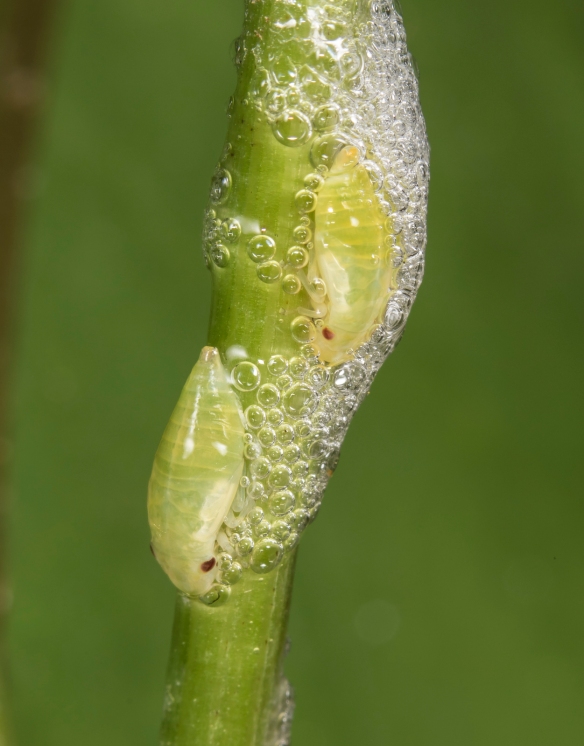In the spring, the eastern half of North America turns into one big spittoon…
~Amy Breau
They have always fascinated me, these little blobs of “spit” on vegetation. Must be the leftover 4th grade boy that still resides in one corner of my brain.
Once or twice a year, I can’t resist the urge to touch one of the the little balls of spit, gently brushing away the foam to see what lies beneath. It is usually the same little green blob of an insect that greets me.
Usually there is only one, but this year, after reading there are often multiples hidden beneath the bubbles, I actually found two spittlebug nymphs in one of the frothy masses.
The aptly-named spittlebugs are related to other plant-suckers like aphids and cicadas.. The immature stage, or nymph, is the one that creates the spittle (it has also been called frog spit or snake spit) as both a protection from predators, and as the ideal humidity and temperature control chamber that helps them keep from drying out in warm temperatures. The nymph sucks on plant juices while facing head-down on a stem, and uses anal appendages to froth up the excess liquid exuded as a by-product of its feeding habits. The bubbles flow downward with gravity and eventually envelope the nymph. Interestingly, the bubbly mass has good staying power (the bubbles may last several days), which makes me wonder if there might not be some commercial use for whatever it is they use to give their bubbly cover such longevity. Another oddity about this critter is that, unlike most sap-sucking insects, this one tends to tap the xylem, the tissue that transports water from the roots to the shoots. Most other sap feeders use the phloem, the tissue that transports food from the leaves down to the roots as it is generally more nutrient-rich. This may explain why they must process large quantities of fluid (they pump 200+ times their body weight in fluid every day) to sustain themselves.
Adult spittlebugs also feed on sap, and some are considered agricultural pests. Many are known by the common name, froghopper, due to their incredible jumping ability. A few resources state they may be the all-time champion jumpers, worthy of superhero power status, as some froghoppers can leap up over 100 times their body length, the equivalent of a six-foot tall human jumping the height of two football fields!
I am beginning to see some small frothy masses appear again on vegetation at the Garden and references state that, for many species, there are two generations per year. So, you still have time to get out and rub some spittle to see what’s underneath. Just make sure there are no 4th grade boys around.




